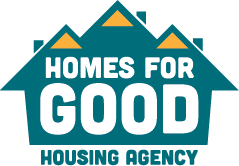In the Housing Choice Voucher Program, commonly known as “Section 8”, Homes for Good provides rental assistance to low-income families accessing a home through the private rental market. To do this, Homes for Good forms a connection between families and landlords. Through the Housing Choice Voucher Program, families maintain secure, quality housing in neighborhoods of their choice.
Under Section 8, Homes for Good pays a fixed amount toward the rent, based on the household income and the applicable payment standard set by the agency. Participants are responsible for finding a suitable unit that:
- Has a gross rent amount that falls within the determined rent limits.
- Can pass a Housing Quality Standards (HQS) inspection.
What size bedroom is your family eligible for under Section 8 or Project Based Vouchers?
Occupancy and Family Composition will be assessed at the time of full application and will determine your voucher size:
- The head of household, including the spouse or co-head, will be allocated one bedroom.
- All other household members will be based on two (2) persons per bedroom, without regard to gender or age.
- Live-in aides will be allocated a separate bedroom. Family members of a live-in aide will not be considered when determining family unit size. See information below about Live-in aides.
- Single person families will be allocated one bedroom.
Live-in Aides
A Live-in Aide is a person who resides with one or more elderly persons, or near elderly persons, or persons with disabilities, and who:
- Is determined to be essential to the care and well-being of the persons,
- Is not obligated for the support of the persons
- Would not be living in the unit except to provide the necessary supportive services.
Elderly is defined as a person who is atleast 62 years of age.
Near Elderly is defined as a family whose head, spouse, or sole member is a person who is at least 50 years of age but below the age of 62; or two or more persons, who are at least 50 years of age but below the age of 62, living together; or one or more persons who are at least 50 years of age but below the age of 62 living with one or more live-in aides.
Disability is defined as a person who has a disability as defined under the Social Security Act or Developmental Disabilities Care Act, or a person who has a physical or mental impairment expected to be of long and indefinite duration and whose ability to live independently is substantially impeded by that impairment but could be improved by more suitable housing conditions. This includes persons with AIDS or conditions arising from AIDS but excludes persons whose disability is based solely on drug or alcohol dependence.
The income of a live-in aide is not counted in the calculation of income for the family. Relatives may be approved as live-in aides.
Written verification will be required from a reliable, knowledgeable professional such as a doctor, social worker, or case worker, that the live-in aide is essential for the care and well being of the elderly, near elderly, or disabled family member.
To request a Live-in Aide Packet, visit our Service Center, or call our front desk at (541) 682-3755 .
What is a "Family"
HUD defines family as including but is not limited to the following:
Regardless of actual or perceived sexual orientation, gender identity, or marital status, a single person, who may be an elderly person, disabled person, near-elderly person, or any other single person; or group of persons residing together.
Such group includes but is not limited to:
- A family with or without children (a child who is temporarily away from the home because of placement in foster care is considered a member of the family),
- An elderly family, a near elderly family, a disabled family, a displaced family, or the remaining member of a tenant family.
- A family also includes two or more individuals who are not related by blood, marriage, adoption, or other operation of law but who either can demonstrate that they have lived together previously or certify that each individual’s income and other resources will be available to meet the needs of the family.
